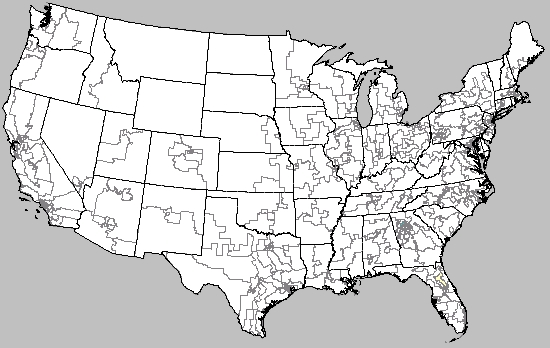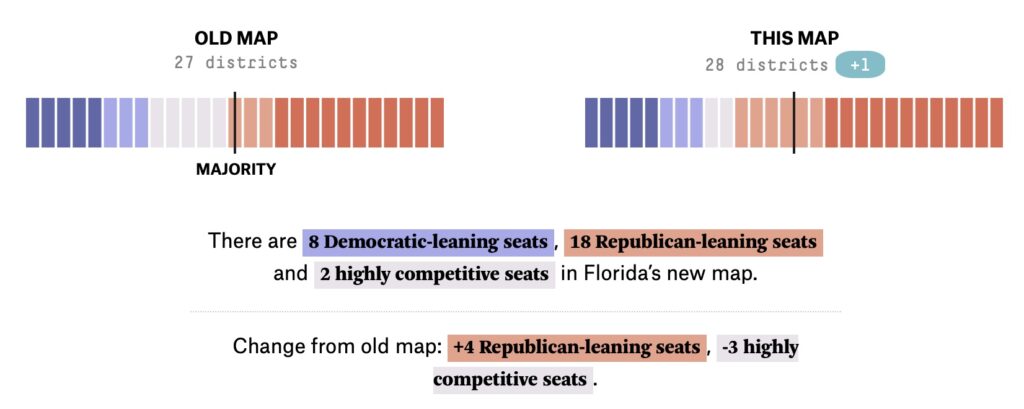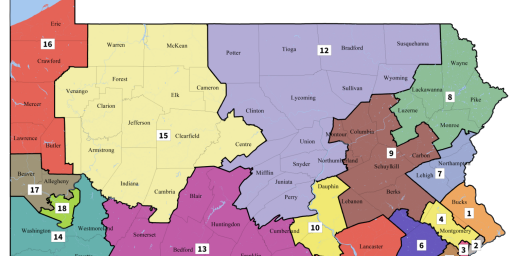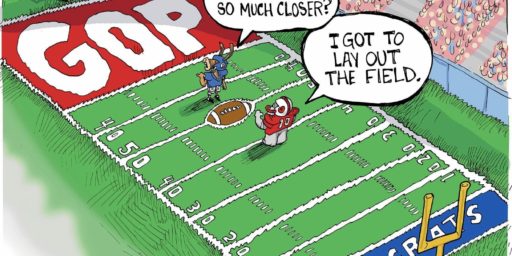Districting and the 2022 House Results
The lines aren't everything, but they need more attention than they get.

Time to circle back to a topic I frequently write about: how the fact that we elect the House in single-seat plurality districts with politically manipulable borders has a lot to do with electoral outcomes. Specifically, as we talk about the seat allocations in the US House of Representatives, I want to remind everyone who is trying to puzzle out why the Republicans didn’t do as well as some thought they might that a lot of the outcome was more foreordained than the horserace vibes suggested on Election Night Eve.
An important caveat, as I think readers sometimes glide over this: I am not saying that the prevailing political climate, candidate quality, or other variables are unimportant, but I am saying that they are a lot less important than people want to make them out to be. I know we want a narrative to explain all things whether it is inflation, Biden’s approval ratings, the Trump factor, or some other storyline, but we need a better national understanding of fundamental factors. Still, goodness knows that anyone in the talking head game is looking for The Narrative to tout.
At any rate, I have noticed that even the data-driven talking heads (like at the FiveThirtyEight politics podcast or on the Ezra Klein Show) are looking pretty hard for The Narrative and often pay less (although not zero) attention to the map and its implications in various ways.
Fundamentally (and this will shock not one regular reader) we need more attention given to how districting affects outcomes more than anything else (instead we get musing about hoodies and campaign styles unlocking blueprints, or some such).
I will again point back to a post from April: A “Fairer” Map for the 2022 House? which quoted a FiveThirtyEight piece that noted:
That’s a net increase of 11 Democratic-leaning seats from the old maps. Meanwhile, the number of Republican-leaning seats has decreased by six, as has the number of highly competitive seats.
Specifically, the balance was projected as follows (although I am not sure what the final balance looked like, as at that time a few states’ maps were unsettled):

In other words, regardless of narratives and other factors, Democrats were likely to do pretty well in 2022 and, perhaps more importantly, a Red Wave outcome was far less likely. It was baked in.
Really, with those districts, a Red Wave in the House would have required a massive shift in the overall electorate toward Republicans in a highly improbable way in our sorted, polarized partisan reality.
It is worth noting that the broad historical trend continued insofar as the House changed hands in favor of the party out of the White House, albeit by a tiny margin. The Senate staying Democratic is not especially surprising, and even with candidate quality questions, fits recent voter behavior in the states in question.
All of this is to say that while there were real chances of more significant Republican gains, the Red Wave possibilities right before Election Night was mostly a combination of Democratic anxiety and the media’s addiction to drama (the two of which fed on themselves). I think it matters that the likely outcome (House goes R, Senate comes down to a known list of close races) was what we got.
Also: preliminary post-election evidence suggests that polling, especially by established firms, was pretty accurate.
Let me note, too, that when we look at Florida and its glowing redness, it is worth noting that the newly drawn congressional districts are more GOP-leaning than the previous set. When observers state that Florida is more Republican than in 2020, one of the reasons is that the new House districts are decidedly more red. You can see the old and new maps at FiveThirtyEight but here’s the breakdown. So while, yes, DeSantis did well and the overall statewide vote was more Republican, it is also true that the House delegation was almost certainly going to be more Republican regardless of DeSantis due to redistricting.

I will note that maps aren’t everything, as the new New York maps were more pro-Democratic and yet Republicans over-performed in that state. Maybe it was the more competitive governor’s race that led to more GOP turnout or, no doubt, a set of factors, but it is worth noting.
One thing about candidate quality that bears consideration: better is always better, so any hypothetical you can conjure wherein you imagine a “better” candidate it is super easy to assume that said better candidate would have won more votes. But since we know nothing about the imaginary candidate save they would be “better” that really doesn’t tell us much, analytically.
And it is worth noting that the objectively better candidate does not always win. Tim Ryan was more qualified than J.D. Vance, yet Vance is going to Washington. And while Fetterman may have won because he was “better” than Dr. Oz but a better version of Fetterman would have beat Oz more soundly, yes? And maybe if Warnock was just a little better, he wouldn’t be in a runoff with Walker.
Better is, after all, always better.
The point is not candidate quality does not matter, but that it is extremely easy to play political “pretend like” and see, oh so obviously, how a better candidate or message would have changed outcomes (but that assumes an awful lot of holding everything else about a given contest as equal and the only thing being changed is a better candidate running, whatever that might mean in context).
The main point is that we need to talk more about these factors so that people can better understand that who controls Washington is very much about structures (in this case, House districts specifically but also state borders) more than it is about which side told the better story to the public and then the public decided which tale they preferred unfiltered by any other variables (and that description of politics suffuses more media discussions of our politics). I think this to be problematic for multiple reasons, not the least of which being that it is a grossly inaccurate simplification. Just consider how different the vibes would be at the moment if the 2022 set of maps looked more like the 2012 set–it almost certainly would have resulted in more Republican seats and therefore a lot less talk of Republican Civil Wars or headaches for Speaker McCarthy.
And the problem is not just about the varying number, decade-to-decade, of competitive seats, but also the deep red and deep blue districts that utterly discourage any political competition of consequences in those locales (or, worse, open the door via the primaries for extremists like Marjorie Taylor Greene).
tl;dr version: all I want for Christmas is a national media that doesn’t pretend like our politics is about two sides telling a story and then voters picking which story they prefer in unfiltered, fair processes where all you really need to know about the outcomes is personality or which slogan people liked better.






If I were emperor of the world, I’d replace single member districts with multi-member single transferable vote and eliminate the district drawing problem entirely.
This calls to mind other instances in which experts* have tried to emphasize structural factors and de-emphasize (implicitly or explicitly) individual factors. This framing essentially asks the public to accept the reality that they (individuals) matter very little.
For many (most?) people, this feels disempowering. And it also takes the steam out of their (our) attempts to scapegoat the baddies.
Politicians and media are selling a product to these people (ie, us). So one can understand why they are loath to explain, much less emphasize, the structural factors at play. Doesn’t excuse it.
*I use this term descriptively, not pejoratively.
Still waiting for any nQes media to call out Republicans for Second Amendment Solutions. If that’s locker room talk, find a new locker room.
I understand your frustration, and I do not like how the media covers things – including politics – but the media is not in the business of comparative politics – that’s really your job.
And the media does point out that many races are not competitive and that people tend to be partisan in their voting patterns. They don’t do it in every piece, nor should they. Maybe not as often as you’d like, but they do point that out, and the infographics show that pretty clearly. And they concentrate on the competitive races for this reason – they are the deciding races.
I think anyone who pays even passing attention to politics understands that many races are not competitive. And this fact is probably why a lot of people don’t bother to be engaged in politics to begin with, because, what’s the point?
The media’s primary role is to report on races in the system as it exists, not constantly lament about the flaws – real or perceived – of the system from a comparative politics perspective.
@Andy:
I take the basic point, and hence I try to do what I do.
But I would say that the media doesn’t actually “report on races in the system as it exists” because they report as if there is a fair, open contest wherein both sides makes their case and the people decide. This is simply not what the system is